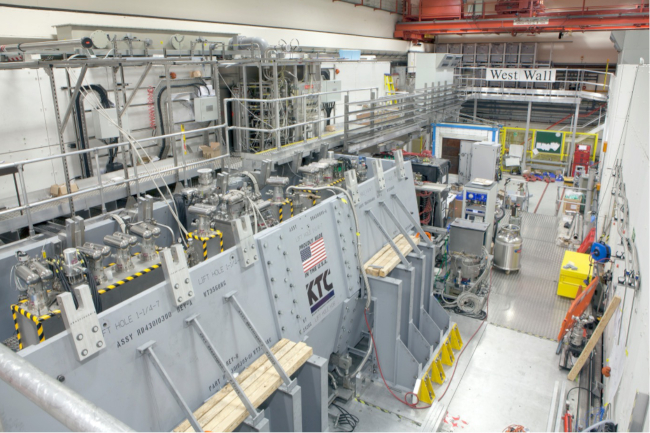A bright future for high-energy muon beams
Published: 22 July 2024
Researchers at the international Muon Ionization Cooling Experiment (MICE) collaboration have shown that muon beams traversing low density absorbers inside strong magnetic fields can reduce their transverse size through the mechanism of 'ionization cooling'.
What will be the next high-energy particle accelerator after the Large Hadron Collider (LHC)? While a much larger proton-proton collider, such as the Future Circular Collider (FCC) being studied at CERN, or a linear electron-positron collider are two possibilities, a high-energy muon collider could be an attractive alternative to understand the fundamental constituents of matter at energies not currently accessible by the LHC.
Protons are composite particles, so the interactions required to produce new particles occur between the proton constituents. Therefore, one requires about seven times larger equivalent energy at a proton collider compared to a muon collider to probe for new particles, making the muon collider more effective for the same energy.
Furthermore, muons are 200 times more massive than electrons, so they can be accelerated to high energies in a circular orbit, so the accelerator facility can occupy a smaller footprint, and hence be more sustainable than the FCC or linear collider options.

One of the main technical challenges to a muon collider is the production of high-brightness muon beams, necessary to increase the number of muon interactions when the two muon beams collide.
In a paper published on 17th July 2024 in Nature Physics, researchers at the international Muon Ionization Cooling Experiment (MICE) collaboration have shown that muon beams traversing low density absorbers inside strong magnetic fields can reduce their transverse size through the mechanism of 'ionization cooling'.
In this paper, the reduction of the phase-space volume of the muons (known as 'emittance reduction') has been measured for the first time. Muons, created from the decays of other subatomic particles called pions, normally occupy a large volume.
This discovery shows that you can channel enough muons into a small enough volume to be able to accelerate the muons and create high-brightness muon beams. In a muon collider, multiple cooling cells with stronger magnetic fields than those achieved at MICE, and with high-gradient radio-frequency cavities to restore the longitudinal beam momentum, will be required before they are injected into the circular accelerator. This paper paves the way to reliably design the high brightness beams at a muon collider.
The research was carried out at the muon beamline at the Science and Technology Facilities Council (STFC) ISIS Neutron and Muon Beam facility at the Rutherford Appleton Laboratory on the Harwell Campus in the UK.
The international Muon Ionization Cooling Experiment (MICE) collaboration, who carried out the research, consists of many scientists from around the world, including a team from the University of Glasgow led by Professor Paul Soler.
The collaboration developed absorbing cells made from lithium hydride, a compound of lithium and hydrogen, and liquid hydrogen cooled to around minus 250 degrees Celsius, encased by extremely thin aluminium windows. The beam was very tightly focussed by powerful superconducting magnetic lenses, and its properties were analysed using very accurate tracking equipment inside a magnetic field and timing sensors with an accuracy of less than 100 picoseconds (one tenth of a billionth of a second).
The Glasgow team contributed to all parts of the experiment, including hardware, software and analysis of the physics data.
Professor Paul Soler, who was the UK Principal Investigator on the project, said: "The measurement of transverse emittance reduction by the MICE collaboration makes the high-energy muon collider a realistic possibility to explore subatomic physics beyond the Large Hadron Collider. We are extremely grateful to STFC in the UK, and to other international funding agencies for their support and to the excellent staff at the ISIS neutron and muon source for hosting the facility.”
First published: 22 July 2024
<< July

